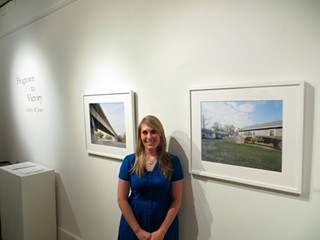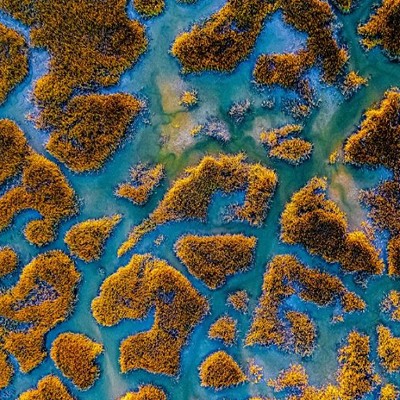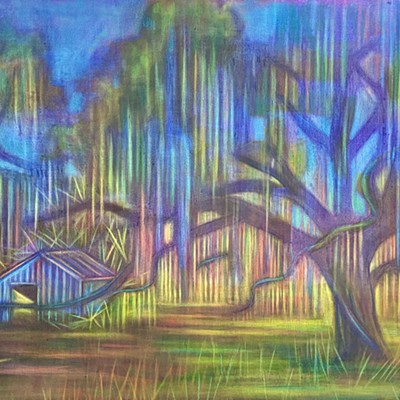Ian Rilliet's 'Idio' at Oglethorpe Gallery
MFA Photography candidates continued to impress this week with sharp thesis exhibitions.
Ian Rilliet presented "Idio" at Oglethorpe Gallery this weekend. According to his artist statement, the Greek term, "idio," refers to "the personal, separate, and distinct," and his collection of photographs "explores the creation of a personal idiom." With precedents in Guy DeBord and the Situationists' concept of dérive, or drift, Rilliet's photographs ask viewers to examine their perceptual practices, shedding light on how we interact with space, mark sites and form personal, idiomatic relationships with our world.
Rilliet said he chose the narrow Oglethorpe Gallery because of how well it presents small-scale images. Indeed, it was hard to imagine this project in any other space. Oglethorpe's wide, square columns were ideal for Rilliet's large-scale images, and the inset walls between the columns were perfect for asymmetric arrangements of his smaller works.
This placement gave the show an impeccable rhythm. Upon entering the gallery, an image of a dead deer, the tip of its muzzle alone in view, drew viewers into the exhibit. Like a grand brushstroke recalling the Abstract Expressionist gesture, blood smeared across an unfinished floor from some unseen wound gave the photograph a painterly feel. Just to the right of that image, a group of smaller photographs featured non-hierarchically organized visual elements intended to be associated with one another by the viewer. Among the smattering of images, a dead cat, dismembered bird, discarded sock and broken twigs and snapped branches called to mind decay, separation and mortality. Such varying examples invited consideration of how we respond to the realities of death and destruction: we tend to imbue a crushed and bloodied housecat with more significance than the stiff corpse of a fallen bird.
Aside from gauging emotional attachment, stories in each group of photographs awaited the viewer to invent them. With no titles, captions or any mode of artist-imposed meaning, beholders were free to make independent connections between the image-fragments. Whether in the form of narratives constructed of the photographed settings and objects, or formal comparisons between such structures as window panes and crucifixes, Rilliet's exhibition was a space for attending to one's own habits of seeing. His success in executing his concept was outshined only by the deft, thoughtful curation of his exhibition.
Ashley Jones's 'Frogtown to Victory' at Ashmore
Drawing from a background in journalism and photojournalism, Ashley Jones presented audiences an investigative project three years in the making. Her work illuminated the dramatic changes to the city's urban fabric that resulted from the development of the interstate highway system. To produce her MFA Photography thesis exhibition, she turned to coursework in SCAD's Historic Preservation program, consulted with Cultural Resource and Urban Planning Manager Ellen Harris at the Chatham County-Savannah Metropolitan Planning Commission and drew from the photographic tradition inaugurated by Lewis Hines, whose work contributed to child labor reform in the United States in the first quarter of the twentieth century.
Jones's photographs of structures in various states of dilapidation engaged other photographic precedents, such as Bernd and Hilla Becher's obsessive typologies of German industrial buildings executed since the late 1950s and Joel Sternfeld's 1997 project "On this Site," a series of banal photographs of sites made memorable by trauma.
The Interstate 16 flyover haunted Jones's photographs, just as it irrevocably impacted the Martin Luther King, Jr. Boulevard corridor. Nestled on MLK, Ashmore Gallery enhanced contemplation of the exhibition, located a stone's throw, for instance, from where the interstate barricades the posh end of Jones Street from its decrepit counterpart to the west.
Including maps that registered the changes in the corridor's footprint since the late nineteenth century, Jones's socio-political project was well-researched, well-executed and well-photographed. More, her articulation of the automobile's historic impact on local communities jells with significant issues in the present: her photographs question why we would allow our cities and activities to be determined by a vehicle that commits as much violence to the life of the community as it does to the life of the planet.


























